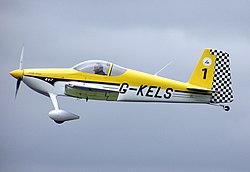Bagian-bagian pesawat
Fuselage
The fuselagefrom the French fuselé "spindle-shaped") is an aircraft's main body section that holds crew and passengers or cargo. In single-engine aircraft it will usually contain an engine, although in some amphibious aircraft the single engine is mounted on a pylon attached to the fuselage which in turn is used as a floating hull.
The fuselage also serves to position control and stabilization surfaces
in specific relationships to lifting surfaces, required for aircraft
stability and maneuverability.
Types of structures

Piper PA-18 welded tube truss fuselage structure
Truss structure
Main article: Truss
This type of structure is still in use in many lightweight aircraft using welded steel tube trusses. A box truss fuselage structure can also be built out of wood—often covered with plywood—as can be seen on this Ibis canard fuselage.
Simple box structures may be rounded by the addition of supported
lightweight stringers, allowing the fabric covering to form a more
aerodynamic shape, or one more pleasing to the eye.Geodesic construction
Main article: Geodesic airframe

Geodesic airframe fuselage structure is exposed by battle damage
Monocoque shell

The Van's Aircraft RV-7 fuselage is slender for high speed flight
Semi-monocoque

Sectioned fuselage showing frames, stringers and skin all made of aluminium
Both monocoque and semi-monocoque are referred to as "stressed skin" structures as all or a portion of the external load (i.e. from wings and empennage, and from discrete masses such as the engine) is taken by the surface covering. In addition, all the load from internal pressurization is carried (as skin tension) by the external skin.
The proportioning of loads between the components is a design choice dictated largely by the dimensions, strength, and elasticity of the components available for construction and whether or not a design is intended to be "self jigging", not requiring a complete fixture for alignment.
Materials
Early aircraft were constructed of wood frames covered in fabric. As monoplanes became popular, metal frames improved the strength, which eventually led to all-metal aircraft with metal covering all surfaces. Some modern aircraft are constructed with composite materials for major control surfaces, wings, or the entire fuselage such as the Boeing 787. On the 787, it makes possible higher pressurization levels and larger windows for passenger comfort as well as lower weight to reduce operating costs. The Boeing 787 weighs 1500 lb less than if it were an all-aluminum assembly.[citation needed]Wing integration
"Flying wing" aircraft, such as the Northrop YB-49 Flying Wing and the Northrop B-2 Spirit bomber have no separate fuselage; instead what would be the fuselage is a thickened portion of the wing structure.Conversely there have been a small number of aircraft designs which have no separate wing, but use the fuselage to generate lift. Examples include National Aeronautics and Space Administration's experimental lifting body designs and the Vought XF5U-1 Flying Flapjack.
A blended wing body can be considered a mixture of the above. It carries the useful load in a fuselage producing lift. A modern example is Boeing X-48. One of the earliest aircraft using this design approach is Burnelli CBY-3, which fuselage was airfoil shaped to produce lift.

Tidak ada komentar:
Posting Komentar